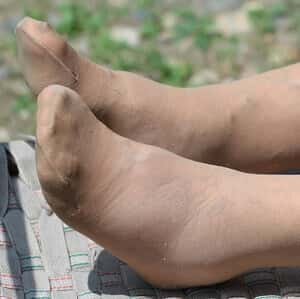
Q. I am taking the blood pressure drug amlodipine (Norvasc) along with benazepril (Lotensin). I have experienced tremendous swelling of my hands, feet and ankles.
My doctor seems unconcerned about these side effects and has suggested adding a diuretic. That would mean taking three drugs to control my relatively mild hypertension. I average around 142/85.
Are there any natural products I could take of foods that might lower my blood pressure without causing this awful swelling? I cannot fit in my shoes but cannot afford to buy three or four new pairs just because of my medicine.
A. Amlodipine plus benazepril (Lotrel) is a popular blood pressure combination. The calcium channel blocker amlodipine relaxes muscles around blood vessels, thereby causing vasodilation and lowering blood pressure.
You have experienced the most common complication of amlodipine, peripheral edema. Fluid accumulates in feet and ankles. Although it is hard to get a handle on the exact incidence of this adverse reaction, we have seen numbers ranging from a low of 5% to a high of 70%. In theory, adding benazepril to amlodipine should lessen peripheral edema compared to amlodipine by itself, but it is no panacea as you have learned.
Here are some other side effects to be aware of with this combination:
Amlodipine + Benazepril (Lotrel) Side Effects
- Edema (swollen ankles, swollen feet, swollen hands)
- Cough
- Dizziness
- Headache
- Flushing
- Fatigue
- Sleepiness
- Nausea
- Palpitations
- Peripheral neuropathy
- Skin rash (requires prompt medical attention)
- Elevated uric acid levels
- Kidney function reduced
- Swelling of face or neck (angioedema)
- Swelling of intestines (abdominal angioedema)
- Elevated potassium levels
- Liver toxicity
- Irregular heart rhythms
You may want to ask your doctor whether amlodipine is absolutely essential for controlling your mild to moderate high blood pressure. Trying to solve the peripheral edema side effect by adding another drug seems a bit counterintuitive to us. This is a discussion worth having with your doctor. Point out that you are not prepared to buy new shoes to accommodate the adverse reaction to amlodipine.
Here are some other stories from people who have experienced side effects related to amlodipine or benazepril.
“Amplodipine makes me feel dragged down, tired, sluggish, and sometimes I almost pass out.
Long term users have repeatedly stated that this medicine made them feel badly, then they stop, and feel way better.
I’m contemplating stopping this stuff. The VA has limited kinds of BP meds. And, they are always always always the cheapest generics one can find.
I’m about to ask if they can go outside and special order as I’m tired of the way this stuff makes me feel. Heck with all the dizziness, about to pass out mess, and the whole ordeal.”
TurboPh.D.
“I’ve been taking amalodopina since 2010 and my feet are now swollen and ankles are nowhere to be seen. I also have a skin rash that doesn’t seem to heal and this has been going on since I started taking this additional medicine.”
John
“I have been taking amlodipine for years without side effects although now I see that it can cause dizziness and I do have balance problems. But all of a sudden my feet and ankles have swollen horribly. They are like play dough. I can press with my fingers and the skin doesn’t pop back. It leaves an indentation. I’ve gone for an arterial doppler and a venal doppler but nothing showed. I’m taking a water pill but that doesn’t help.”
John
“I’ve had a terrible cough–so violent I’ve wet and sometimes even soiled myself. For the past several weeks I’ve been vomiting from coughing so hard.
I take lisinopril and amlodipine for high blood pressure. I suspect that one of them is the cause of my horrid cough.”
Lyn
Lyn is right. Almost assuredly it is the lisinopril that is causing the horrible cough. Virtually all the “prils” including lisinopril and benazepril can cause a terrible cough that cannot be controlled by cough medicine. Finding the best approach to blood pressure control that won’t cause unacceptable side effects requires careful collaboration with a health care provider who is willing to listen and change treatment when adverse reactions arise. Check out our Guide To Blood Pressure Treatment for some nondrug approaches.

